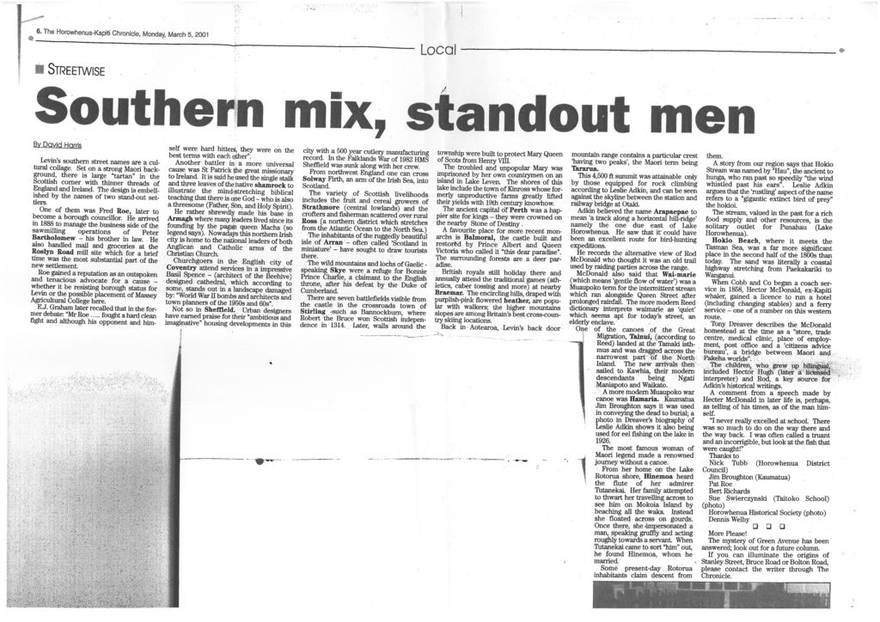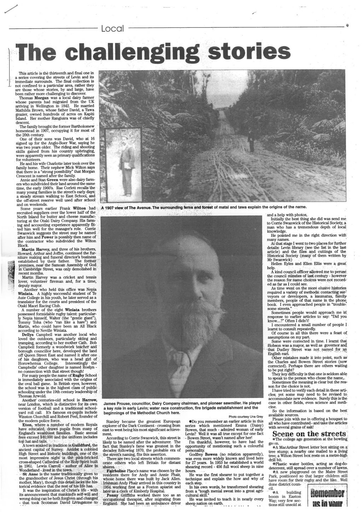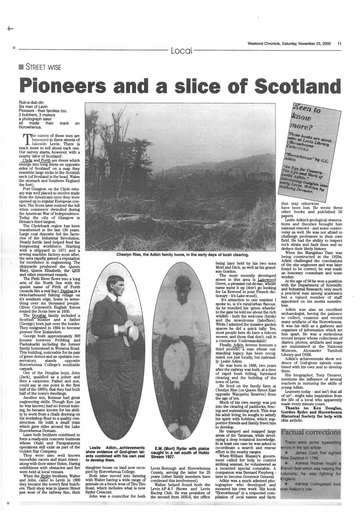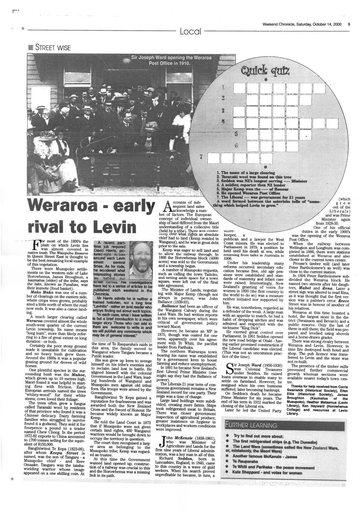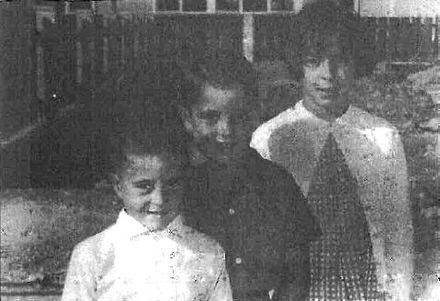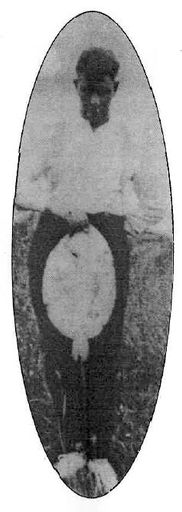Southern mix, Standout men
- Description
Levin's southern street names are a cultural collage. Set on a strong Maori back-ground, there is large "tartan" in the Scottish corner with thinner threads of England and Ireland. The design is embellished by the names of two stand-out settlers. One of them was Fred Roe, later to become a borough councillor. He arrived in 1888 to manage the business side of the sawmilling operations of Peter Bartholomew - his brother in law. He also handled mail and groceries at the Roslyn Road mill site which for a brief time was the most substantial part of the new settlement. Roe gained a reputation as an outspoken and tenacious advocate for a cause - whether it be resisting borough status for Levin or the possible placement of Massey Agricultural College here. E.J. Graham later recalled that in the former debate: "Mr Roe ..... fought a hard clean fight and although his opponent and himself were hard hitters, they were on the best terms with each other".
Another battler in a more universal cause was St Patrick the great missionary to Ireland. It is said he used the single stalk and three leaves of the native shamrock to illustrate the mind-stretching biblical teaching that there is one God - who is also a threesome (Father, Son, and Holy Spirit). He rather shrewdly made his base in Armagh where many leaders lived since its founding by the pagan queen Macha (so legend says). Nowadays this northern Irish city is home to the" national leaders of both Anglican and Catholic arms of the Christian Church. Churchgoers in the English city of Coventry attend services in a impressive Basil Spence - (architect of the Beehive) designed cathedral, which according to some, stands out in a landscape damaged by: "World War 11 bombs and architects and town planners of the 1950s and 60s".
Not so in Sheffield. Urban designers have earned praise for their "ambitious and imaginative" housing developments in this city with a 500 year cutlery manufacturing record. In the Falklands War of 1982 HMS Sheffield was sunk along with her crew.
From northwest England one can cross Solway Firth, an arm of the Irish Sea, into Scotland.
The variety of Scottish livelihoods includes the fruit and cereal growers of Strathmore (central lowlands) and the crofters and fisherman scattered over rural Ross (a northern district which stretches from the Atlantic Ocean to the North Sea.) The inhabitants of the ruggedly beautiful isle of Arran - often called 'Scotland in miniature' - have sought to draw tourists there. The wild mountains and lochs of Gaelic - speaking Skye were a refuge for Bonnie Prince Charlie, a claimant to the English throne, after his defeat by the Duke of Cumberland. There are seven battlefields visible from the castle in the crossroads town of Stirling -such as Bannockburn, where Robert the Bruce won Scottish independence in 1314. Later, walls around the township were built to protect Mary Queen of Scots from Henry VIII.
The troubled and unpopular Mary was imprisoned by her own countrymen on an island in Lake Leven. The shores of this lake include the town of Kinross whose formerly unproductive farms greatly lifted their yields with 19th century knowhow. The ancient capital of Perth was a hap-pier site for kings - they were crowned on the nearby Stone of Destiny.
A favourite place for more recent monarchs is Balmoral, the castle built and restored by Prince Albert and Queen Victoria who called it "this dear paradise". The surrounding forests are a deer paradise. British royals still holiday there and annually attend the traditional games (athletics, caber tossing and more) at nearby Braemar. The encircling hills, draped with purplish-pink flowered heather, are popular with walkers; the higher mountains slopes are among Britain's best cross-country skiing locations. Back in Aotearoa, Levin's back door mountain range contains a particular crest 'having two peaks', the Maori term being Tararua. • This 4,500 ft summit was attainable only by those equipped for rock climbing according to Leslie Adkin, and can be seen against the skyline between the station and railway bridge at Otaki. Adkin believed the name Arapaepae to mean 'a track along a horizontal hill-ridge' namely the one due east of Lake Horowhenua. He saw that it could have been an excellent route for bird-hunting expeditions. He records the alternative view of Rod McDonald who thought it was an old trail used by raiding parties across the range. McDonald also said that Wai-marie (which means 'gentle flow of water') was a MuauPoko term for the intermittent stream which ran alongside Queen Street after prolonged rainfall. The more modern Reed dictionary interprets waimarie as 'quiet' which seems apt for today's street, an elderly enclave. One of the canoes of the Great Migration, Tainui, (according to Reed) landed at the Tarnaki isthmus and was dragged across the narrowest part Of the North Island. The new arrivals then sailed to Kawhia, their modern descendants • being Ngati Maniapoto and Waikato. A more modern Muaupoko war canoe was Hamaria. Kaumatua Jim Broughton says it was used in conveying the dead to burial; a photo in Dreaver's biography of Leslie Adkin shows it also being used for eel fishing on the lake in 1926.
The most famous woman of Maori legend made a renowned journey without a canoe. From her home on the Lake Rotorua shore, Hinemoa heard the flute of her admirer Tutanekai. Her family attempted to thwart her travelling across to see him on Mokoia Island by beaching all the waka. Instead she floated across on gourds. Once there, she impersonated a man, speaking gruffly and acting roughly towards a servant. When Tutanekai came to sort "him” out, he found Hinemoa, whom he married. Some present-day Rotorua inhabitants claim descent from them.
A story from our region says that Hokio Stream was named by "Hau", the ancient to hunga, who ran past so speedily "the wind whistled past his ears". Leslie Adkin argues that the 'rustling' aspect of the name refers to a "gigantic extinct bird of prey" the hokioi.
 The stream, valued in the past for a rich food supply and other resources, is the solitary outlet for Punahau (Lake Horowhenua). Hokio Beach, where it meets the Tasman Sea, was a far more significant place in the second half of the 1800s than today. The sand was literally a coastal highway stretching from Paekakariki to Wanganui.
The stream, valued in the past for a rich food supply and other resources, is the solitary outlet for Punahau (Lake Horowhenua). Hokio Beach, where it meets the Tasman Sea, was a far more significant place in the second half of the 1800s than today. The sand was literally a coastal highway stretching from Paekakariki to Wanganui.When Cobb and Co began a coach service in 1858, Hector McDonald, ex-Kapiti whaler, gained a licence to run a hotel (including changing stables) and a ferry service - one of a number on this western route. Tony Dreaver describes the McDonald homestead at the time as a "store, trade centre, medical clinic, place of employment, post office and a 'citizens advice bureau’, a bridge between Maori and 'Pakeha worlds". - The children who grew up bilingual included Hector Hugh (later a licensed interpreter) and Rod, a key source for Adkin's historical writings.
A comment from a speech made by Hector McDonald in later life is, perhaps, as telling of his times, as of the man him-self. "I never really excelled at school. There was so much to do on the way there and the way back. I was often called a truant and an incorrigible, but look at the fish that were caught!"
Thanks to Nick Tubb (Horowhenua District Council),
· Jim Broughton (Kaumatua),
· Pat Roe
· Bert Richards
· Sue Swierczynski (Taitoko School) (photo)
· Horowhenua Historical Society (photo)
· Dennis Welby
More Please! The mystery of Green Avenue has been answered; look out for a future column.
If you can illuminate the origins of Stanley Street, Bruce Road or Bolton Road, please contact the writer through The Chronicle.
Very odd numbers
People who love maths often enjoy predicting the next in a pattern of numbers. How about 1, 2, 3, 4, 5, 7, 9 If you're travelling down Roslyn Road you'll notice that the house numbers jump from 9 to 20 and continue as evens. The explanation for this pattern is that the beginning of the road has only space on one side only and by number 20 the rural numbering system is used. (Here the number measures how many metres since the start of the road. A great help for fire brigades ... and others).Miro Street is all even and Kauri Street virtually all odd.
Lakewood Grove is missing some numbers, presumably as some sections have been combined under single titles. Queen Street is numbered from the middle of town outwards, allowing for growth of course. The westward arm has the lower numbers, reaching 183 at Te Kowhai. However the eastern branch, beginning at the Oxford Street intersection, was arbitrarily set to start at 500. (So beware someone who gives their address as 322 Queen Street - it doesn't exist!) The strangest of the lot is the T-shaped Ryder Crescent which is numbered normally (up to 20) on the left branch but on the right suddenly leaps into the hundreds. The reason is that there was a much larger subdivision envisaged here in the 1970s; it was cut back after the 'oil shock' and economic downtown of that decade.
Developers 'of Surrey Place and Cumberland Court, Warren and Susan Diffey sat down with a map of England to choose names in keeping with surrounding streets.
Corrie Swanwick has pointed out that Bernard Freyberg was not a 'dental mechanic' while in Levin - rather a qualified dentist Peter McKenzie, whose father Stuart employed the future Governor-General, confirms this, explaining that Freyberg carried out a range of dental work in the town. Interestingly this "mechanic myth" has been perpetuated in at least three publications. Please speak out if you spot any such errors in these columns.
A couple of facts from the last article which were lost in typesetting errors: George Street is named after George Astridge
Winslow Place was named by Sue Welsh who grew up in England.
Identification
- Date
- March 5, 2001
Taxonomy
- Community Tags

